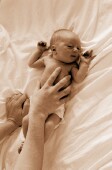
TUESDAY, July 15, 2014 (HealthDay News) — New research suggests that genes may play a role in cerebral palsy, the most common cause of physical disability in children.
Previous research has identified several pregnancy-related risk factors, including preterm delivery, abnormal growth, exposure to infection and lack of oxygen at birth. A possible family link with cerebral palsy has also been found, but not confirmed.
Cerebral palsy affects your ability to move, and alters your balance and posture.
In this study, researchers analyzed data from more than 2 million births in Norway between 1967 and 2002. They identified more than 3,600 cases of cerebral palsy, or 1.8 cases for every 1,000 children born during that period.
The rate was higher among twins (5.1 per 1,000 children) than among single children (1.7 per 1,000 children). If one twin had cerebral palsy, the other twin had a 15 times increased risk of the condition.
If one child in a family had cerebral palsy, full siblings who were born later had a six to nine times increased risk, and half siblings had up to a three times increased risk. Children born to parents with cerebral palsy were 6.5 times more likely to have the condition than those born to unaffected parents.
Even first cousins of people with cerebral palsy had a 1.5 times increased risk, according to the findings in The BMJ. It’s the first study to examine cerebral palsy over such a wide range of family links.
“Our data suggest that cerebral palsy includes a genetic component, with a stronger recurrence among relatives with closer genetic relationship,” the researchers wrote.
When a child is born with cerebral palsy, parents want to know whether they did anything to cause the condition, and whether it may recur in other children or grandchildren, pediatrician Dr. Peter Rosenbaum wrote in an accompanying commentary.
He noted that the search for the causes of cerebral palsy is “far from over,” but added that even family members with a 15 times increased risk have a small actual risk of the condition.
“This information should provide some reassurance to families in which cerebral palsy is already present,” Rosenbaum concluded.
More information
The U.S. National Library of Medicine has more about cerebral palsy.
Copyright © 2025 HealthDay. All rights reserved.

